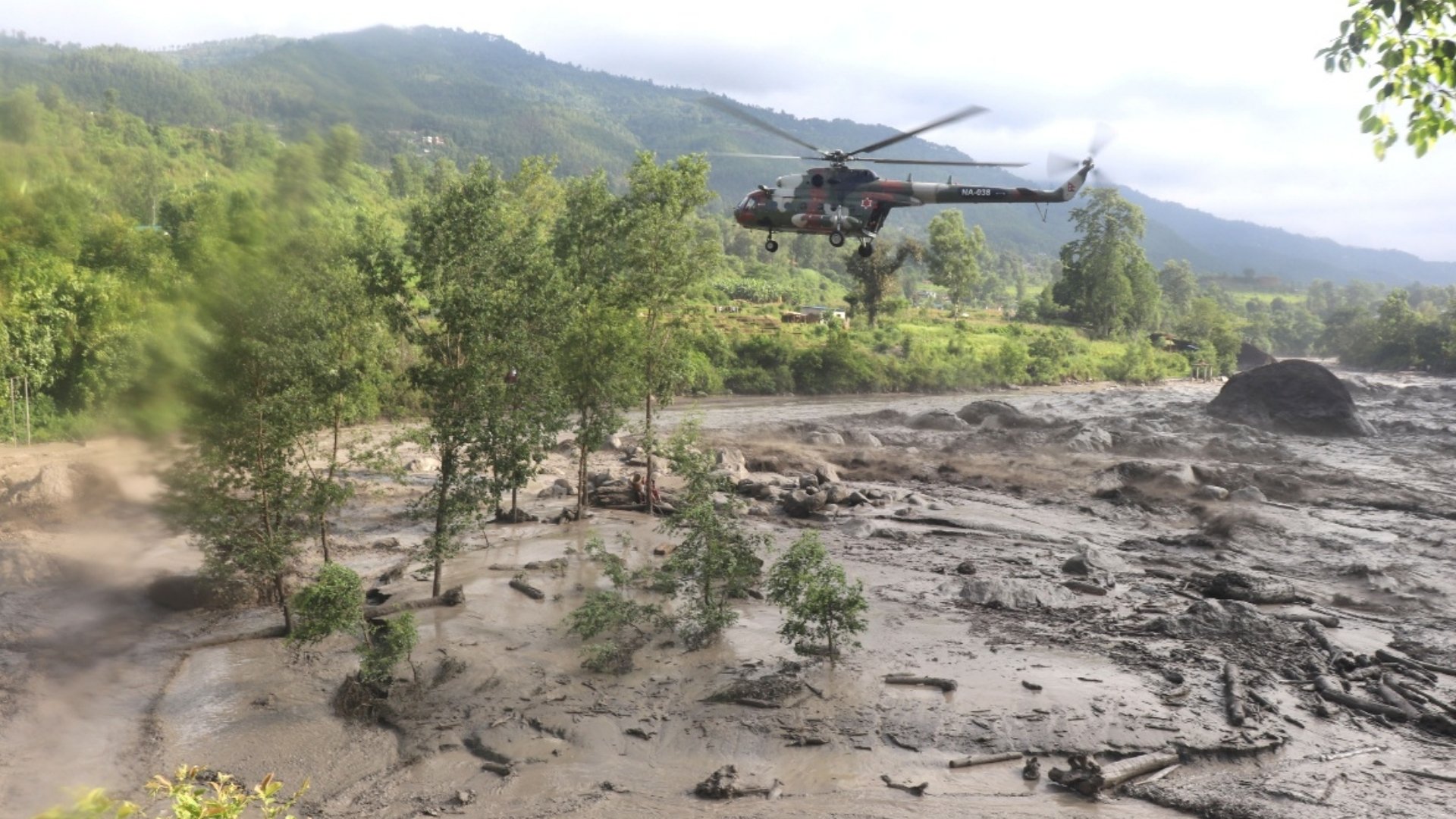BhoteKoshi River Flood | Rasuwa District Disaster | Miteri Bridge Collapse | GLOF

A total of seven people have been dead in a massive flood in the BhoteKoshi river that struck the Rasuwa district’s Nepal and China border during the early hours today. According to the Nepal Police update, 18 people—three policemen, nine customs office employees, and six Chinese citizens, have gone missing.
A 21-member joint team from the Armed Police Force (APF) and the Nepali Army has been deployed to carry out rescue operations in the flood-affected areas, with 55 people successfully rescued so far.
However, ongoing rescue efforts have been hampered by severe weather conditions and damaged roads—particularly the Syaphrubensi-Rasuwagadhi stretch of the Pasang Lhamu Highway—which have delayed the transport of essential equipment and personnel to the disaster zone.
No heavy rainfall recorded, glacial lake outburst likely cause
At around 3 am, a sudden and massive flood appeared to have entered the Bhotekoshi River from the Tibet region, says the Department of Hydrology and Meteorology (DoHM) in its preliminary assessment of the flood, suddenly elevating the water level near Rasuwa–Timure by about 3.5 metres.
According to the DoHM, there was no massive rainfall on either side of the country. Weather stations at Kyangjin and Dhunche in Rasuwa, near the Nepal-China border, recorded minimal to no rainfall, according to its measurements.
Similarly, the World Meteorological Organization’s satellite-based estimates reported no rainfall in the upper Bhotekoshi watershed over the past 24 hours.
Based on the available information, the DoHM has determined rainfall as the unlikely cause and indicated the possibility of a glacial lake outburst. The BhoteKoshi watershed in Tibet is home to several glaciers, it adds.
The department has already submitted an emergency request to the Sentinel Asia Platform to obtain the latest satellite imagery to determine the cause of the flood and assess its impact along the riverbanks.
The flood also resulted in the elevated water levels in Trishuli river. The Trishuli Betrawati Hydrological Measurement Station in Nuwakot, located about 41 kilometres downstream from the Rasuwagadhi border, recorded a sudden surge in water flow at 5 am in the morning. The water level at the station was 1.60 meters (around 220 cubic meters per second) at 5 am, rising sharply to 3.63 meters by 5:10 am and to 4.18 meters at 5:50 am, with a peak flow of roughly 1,600 cubic meters per second.
As water levels rose, the DoHM issued a warning this morning of a high risk of flash floods in Rasuwa, Nuwakot, Dhading, and nearby districts. Although water levels have since receded, the department cautions that the flood risk remains.
Severe infrastructure damage
Today’s flood has disrupted several infrastructures, including washing away the Miteri Bridge. The bridge, over a hundred metres long, is a transit link between Nepal and China which was closed for a long period during and after the Covid pandemic and resumed operations just in May last year.
It has also hit the Customs office in the district’s Timure area, sweeping away several vehicles parked at the Rasuwa dry port and customs yard—including eight electric vehicles (EVs). With nine loaded containers gone, goods awaiting customs clearance have been swept downstream. People from the Sindhupalchowk area, who were at the customs zone at the time, are also reported to be stranded.
The major hydropower projects operating in the district are currently at a halt due to the flood damages, impacting the energy production of up to 200 MW. The 111 MW Rasuwagadhi Hydropower Dam, with its gate swept away, and the 22 MW Chilime plant’s trailrace are damaged after the flood water swept through. The hydropower projects in the vicinity, such as Trishuli 3-A and Trishuli 3-B, are currently on pause due to the flood damages.
Earlier in 2016, a flash flood struck the Bhotekoshi River, affecting the Tatopani area of the Sindhupalchowk district along the Nepal-China border. The flood, triggered by persistent rainfall over a few days, swept away over 50 houses in the area.
Meanwhile, this year the government has allocated two billion rupees for the road development along Galchhi to Rasuwagadhi section. Additionally, a week ago, the Green Climate Fund (GCF) approved a fund of $36.1 million for Nepal to support Nepal’s efforts to mitigate climate threats in the Himalayas, focusing on Glacial Lake Outburst Floods (GLOFs).
Read More Stories
Kathmandu’s decay: From glorious past to ominous future
Kathmandu: The legend and the legacy Legend about Kathmandus evolution holds that the...
Kathmandu - A crumbling valley!
Valleys and cities should be young, vibrant, inspiring and full of hopes with...
Today’s weather: Monsoon deepens across Nepal, bringing rain, risk, and rising rivers
Monsoon winds have taken hold across Nepal, with cloudy skies and bouts of...